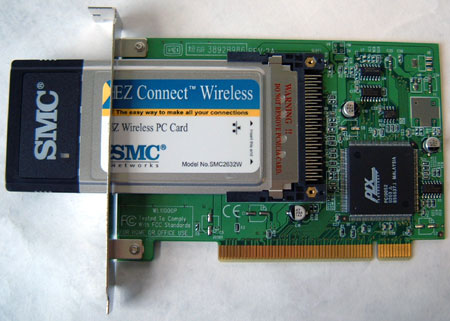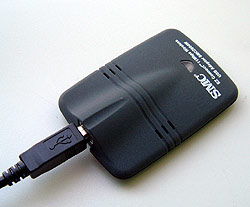Rather than using embedded
circuitry on the PCB, the SMC EZconnect PCI card makes use of a
standard PCMCIA 802.11b adaptor card. The only downside to this set up is that
SMC have put a piece of tape down so that the PCMCIA card is not really that
removable.
With the antenna sticking out of a computer it makes a prime target for getting
snapped off if the computer case is ever moved around.
| smc
networks -pci |
|

|
Hardware Installation:
Installation of the PCI card is straight forward. Simply install it into an empty
PCI slot and load in the drivers. Once the computer accepts it, all that remains
is to set the proper SSID, and WEP password. The SMC EZ Connect Utility
makes adjusting all of these settings quick because they are all located at the
bottom corner of the screen - with the signal strength identified with a nice
green icon.

SMC Networks USB
802.11b
Like any other USB device,
the very tiny WLAN adaptor (it measures just 8cm x 5.5cm x 2cm) needs only to
be plugged into an available USB port with the included cable before the
computer will prompt for drivers and install the device as another Network
Adaptor.
| smc
networks -usb |
|

|
Software Installation:
With our
test system running WindowsXP we were unable to install the utility which
shipped with the unit. Instead, we had to go over to www.smc.com and download another set
of drivers which were compatible with Windows XP.

The
wireless USB adaptor worked right off the bat, although
the computer listed the connection as unavailable at first for
some reason. Anyway, the only problems we experience were when 64-bit WEP
was engaged. It seemed as though the windowsXP wireless networking controls were
a bit simplistic when it came to the topic of entering a Pass Phrase (it
only accepts the raw hex-digits). In fact, after we had set the router to 64-bit
WEP it even crashed the test system for some reason. Ultimately, it took some tinkering to
get the USB adaptor talking to the WAP again.
Summary of SMC 802.11b Equipment
Even with the manuals we found that
properly configuring all the various wireless access points is really something
for more advanced users. With changing IP addresses, complex and varying menus for
each particular setting, and a relatively error sensitive web-based configuration system
things can quickly come to the point where the WAP needs to be
reset. Sometimes more than once even.
Once
everything was configured with
the SMC units however, the problems were quickly put behind us
and in general the SMC system operated as it should have. Next up
we have several entries from TrendNet....
